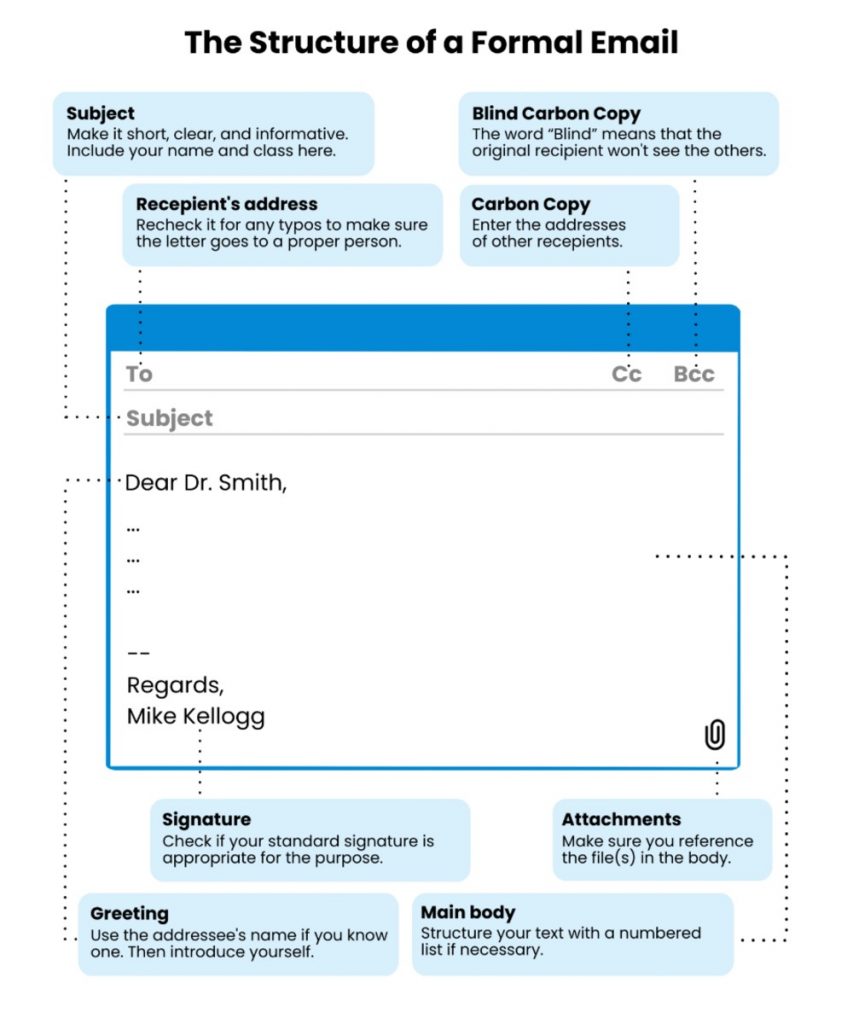When you participate in face-to-face communication, your appearance, tone of voice, and word choice determine the impression you make. In the era of globalization, the internet allows us to contact people we have never seen and might never meet. This online interaction can impact our lives even more than our friends and families. How so?

College is a test-drive for your professional life. Developing proper email etiquette is an essential part of your studies. During your college years, you will communicate with your teachers, apply for scholarships, and respond to job offers, mostly through email. The answers you receive will determine your future. That’s why it’s better to learn these email etiquette rules as soon as possible.
❓ What Is Email Etiquette?
Email etiquette is the name given to the rules that govern the use of appropriate language, phrasing, structure, and other formalities in email correspondence. Proper email etiquette is needed for formal letters addressed to school authorities, company employees, government departments, etc. The rules are numerous but intuitively clear. Sometimes people use the term “email netiquette” to combine the words “net” and “etiquette.”
Why Is Email Etiquette Important?
The way you write emails can reveal a lot about your education, behavior, and attention to detail. Your email etiquette reflects the aspects of your personality.
- Professionalism. Being a student means that you are a professional-to-be. An email is an easy way to convince the reader that you are responsible, capable, and perfect for that scholarship. Show that you are ready for your future career by following these accepted standards of communication.
- Efficiency. Emails differ from handwritten letters in many ways. Generally speaking, a good email is a short one. You demonstrate efficiency when your messages are to the point.
- Respect. Avoid unnecessary embellishments and small talk. This will show the reader that you respect their time and value your own.
📜 How to Write an Email to a Teacher: General Rules
Emailing your teachers is a perfect opportunity to practice proper email etiquette. Teachers will usually point out your mistakes gently since they understand that you are still learning. At the same time, a correct and well-organized email can impress them and make them favorably disposed to you. The following tips will improve your written communication with your college instructors.
📑 The Structure of a Formal Email
Before you set out to structure your letter, make sure that your email address is appropriate for professional communication. Using an address like “kitten666@gmail.com” is not appropriate. Create an address that contains your last name and initials for business and study purposes.

All email platforms follow the same structure given below. You will find some differences in the design and naming of the fields (1 to 4), but their sequence will be the same.
- To (recipient’s address). Enter the address of the person or organization that will receive your letter. If you make a mistake, you will receive a message that such an address does not exist. Recheck for any typos, so your email does not go to the wrong person.
- Copies. Be careful with Listservs when replying to an email. These can be useful when you need to send the same letter to multiple users. However, when responding to such a message, all the users included in the mailout will receive your answer. It is much better to copy the necessary address and paste it in a new email than to simply press the “reply” button.
- CC (Carbon Copy). Enter the email addresses of other people who need to receive your letter. Note that the receiver you indicated in the previous line will see these addresses.
- BCC (Blind Carbon Copy). This field is similar to the previous one, save one detail. The word “blind” means that the original recipient will not know that someone else also received the same message. Be aware that the people whose emails are marked as BCC will see that they are not the original addressees.
- Subject. Make it short, clear, and informative. When emailing your teacher, include your name and class here. Then put the contents of the email in a few words. Avoid vague language.
- Email body. Enter the text of your letter in this field. Try to make it no longer than one screen length. Write in complete sentences with correct grammatical structures. Before you press “Send,” check for spelling errors (not all email platforms provide this feature).
- Greeting. If you know the recipient’s name, use it here. “Dear Sir/Madam” is polite but impersonal. Then explain who you are because your signature will come at the end.
- Main body. If you have several questions or subjects to discuss, structure your text with a numbered list. Consider whether it is better to discuss them in person if there are too many. Always consider the receiver’s feedback. How long will it take them to read your email and answer it? Do your best to cut this time to a minimum.
- Signature. This feature is often automatically attached to any email you send. Check if the wording of your standard signature is appropriate for the purpose of your email. In addition to your name, write your phone number and course name and number here.
- Attachments. If you add an attachment, be sure to reference the file in the main body. Explain why you would like the recipient to review the document. Avoid attaching files that are too large or too numerous. It is often better to combine multiple pictures into one PDF.
✔️ The Ultimate Email Checklist
- Have you specified the recipient’s address?
- Is it the correct email (no typos, and not a “no-reply” email)?
- If you have copy emails, are they in the correct line (CC/BCC)?
- Is the subject clear, short, and informative?
- Does the critical information appear at the top of your email?
- Does the text have a clear structure?
- Can you make your email shorter? If yes, do so.
- Is your signature appropriate for the recipient?
- Does the signature contain all the necessary information?
- Have you attached the necessary files?
- Are their size and format appropriate?
- Have you mentioned the attachments in the body of the email?
👀 Email Etiquette: Bad & Better Examples
Below you’ll find several examples of the emails that are not so good, as well as the explanations and better versions.

Student’s Email Example #1
Student’s Email Example #2
Your business life starts at college. Approach your education as an investment in your future career. Communicating with your teachers is a practical course in business interaction. Using this time to practice can save you a lot of time, money, and effort in the following years.
Choosing the right words is half the battle. The way you present your thoughts reveals your personality to an attentive reader. Following the rules of email etiquette will convince the reader that you are an educated, respectful person.
Share your experiences with email communication in the comments below. Your advice may be valuable to your peers.
🔗 References
- Email Etiquette for Students // Purdue Writing Lab
- Email Etiquette | University of Technology Sydney
- Email etiquette – Current students – University of Melbourne
- Email Etiquette – LinkedIn
- How to Properly Write a Formal Email (That Gets Results)
- How to Write a Professional Email | Indeed.com
- How to Write a Formal Email | Medium
- An introduction to formal emails – Oxford University Press
- An email request | Writing – Advanced C1 | British Council




![41 Top Study Blogs for Students in College [2026 Upd.]](https://custom-writing.org/blog/wp-content/uploads/2020/12/students-in-a-library-284x153.jpg)






![15 Basic Writing Rules – Common Mistakes & Fixes [2026 Upd.]](https://custom-writing.org/blog/wp-content/uploads/2020/12/people-performing-their-job-duties-coworking-space-284x153.jpg)
i think this is very help full.
It was a very informing on how to write a professional email , it also gives a deep explanation , for example bad emails and how to correct them. It also lists more contents to add to make it professional and respectful.
Very informational, I learned a lot from reading this article. I will make sure my emails are professional and to the point.